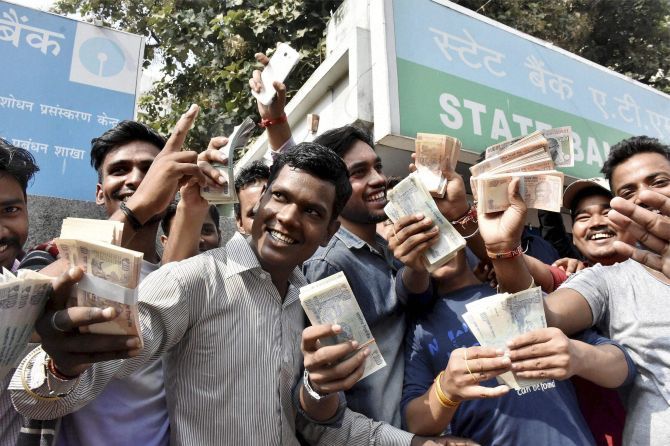 | « Back to article | Print this article |

'If the RBI now only prints Rs 100 in small denomination notes and the remaining amount is printed in Rs 500 and Rs 2,000 denominations, then by March-end the central bank can completely normalise the cash crunch situation,' says Soumya Kanti Ghosh
An objective assessment of note ban impact on GDP growth is tricky because the costs and benefits cannot be properly quantified, says Soumya Kanti Ghosh, Group Chief Economic Advisor, State Bank of India.
Unanticipated monetary policy matters, as it is supposed to, provide surprises. Perhaps, this best sums up the monetary policy committee decision not to cut rates this time.
As economist Alan Blinder says, 'The MPC decision possibly reflects that distinction between individual and group decision-making, while clean in theory, can be fuzzy in practice.'
Interestingly, a study by the Reserve Bank of India had concluded in the past that more empowered MPCs seem to deliver better inflation results but with no improvement in growth outcomes.
The only factor that could have refrained the MPC to maintain the status quo is the oil price risk.
After the OPEC (Oil Producing and Exporting Countries) and non-OPEC deal to cut oil production to stabilise the market, oil prices are expected to touch $60 a barrel.
However, this projection is completely conditional on how US domestic production and inventories shape in the future.
This development will be felt in the fourth quarter of FY17 in a gradual fashion. Hence, the net price impact will depend on rupee-dollar parity.
If the rupee appreciates as currently, this rise can be absorbed without much impact on inflation.
An objective assessment of the impact of demonetisation on GDP growth is tricky because the costs and benefits cannot be properly quantified.
We maintain that the impact on GDP could be limited to 50 to 100 basis point on GDP in Q3.
Also, on an average, at least a 30 bps downward impact on inflation (already from a sub-four per cent base) due to demonetisation could not be ruled out in Q3.
If the RBI keeps 86% of notes in high denominations and 14% in small denominations, then it might have printed a large chunk of small-denomination currency notes and will now focus more on Rs 500 denomination notes.
Going forward, if the RBI now only prints Rs 100 in small denomination notes and the remaining amount is printed in Rs 500 and Rs 2,000 denominations, then by March-end the central bank can completely normalise the cash crunch situation.
But given the objectives of this demonetisation move, with people choosing less cash and more electronic forms of payments, we expect this could be easily quickened to end-January.
Finally, we believe the last word might not have been said on the deposit accretion figure.
We believe we have to wait a little longer to get an exact gauge, as such figures could be a victim of double counting.
This is Soumya Kanti Ghosh's personal view and not the view of his employer.